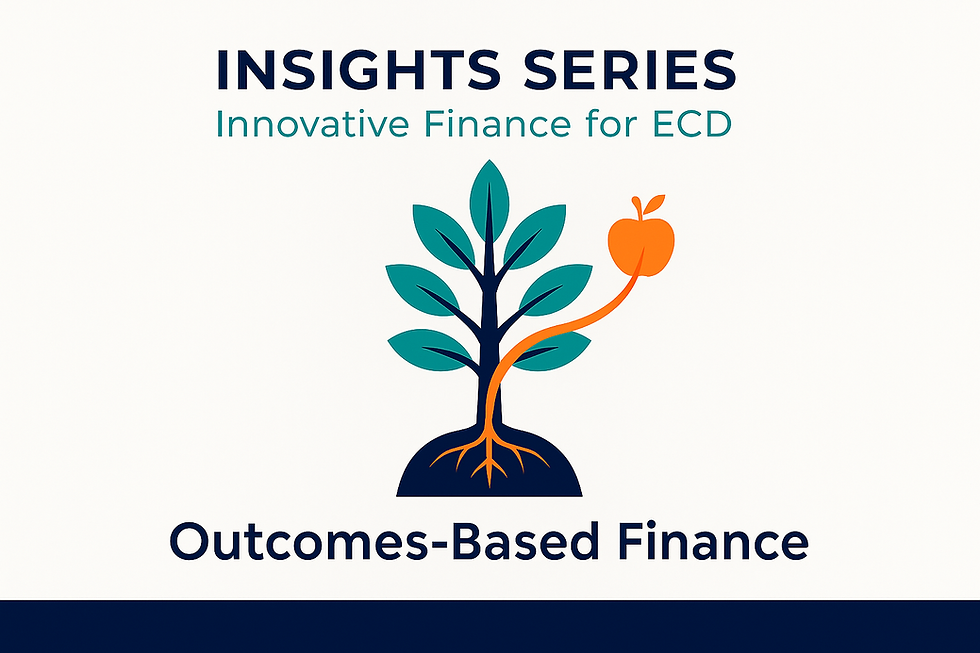New GSG and EOF results-based financing guide: “Tying funding to results”
- jared6212
- Mar 4, 2021
- 3 min read
Updated: Nov 4, 2025
On 13 February 2021, the Global Steering Group for Impact Investment (GSG) published its new “Tying funding to results” action guide, produced in collaboration with the Education Outcomes Fund (EOF).
Looking to build back better in the wake of COVID-19, many governments are balancing the need to support a rapid recovery whilst laying the groundwork for more sustainable economies. For those looking to achieve more and better outcomes to pressing social, economic, and environmental issues, results-based financing (RBF) should be in governments’ tool boxes. RBF offers opportunities to advance and expand investment, through leveraging private capital and improving the effectiveness of existing spending, while ensuring a strong focus on delivering for communities.
The Global Steering Group for Impact Investment’s (GSG) new action guide, ‘Tying funding to results,’ explores how RBF solutions can help to confront some of the most pressing social issues across the globe, with a focus on those issues that have been exacerbated by the pandemic. Created as a response to the GSG National Advisory Boards’ growing interest in adopting RBF to foster impact-driven economies, the guide collates learnings and recommendations from an 80-member working group co-led by the GSG and the Education Outcomes Fund (EOF).
Using an issue-centered approach, the working group identified education, labor market development, and health as three social areas critical to accelerating the nascent recovery from the pandemic. The guide discusses the current landscape for RBF in these sectors, highlighting successful case studies, the impetus for change in each sector, and the potential gains that could be realized with the effective application of RBF.
Zooming in on RBFs in education
In the education context, the report highlights the negative impacts of COVID-19 on pre-existing inequalities in education, noting:
“By April 2020, 90% of all students (1.6 billion learners, 160 million in pre-primary level) were affected by school closures globally. By early January 2021, more than 143 million children were still unable to attend school.”
This gap in learning could have a devastating impact on learning outcomes as:
“Studies on the effects of previous disruptions, from economic crises to diseases and natural disasters, show that prolonged absence from school is associated with lower retention and graduation rates and worse learning outcomes. Evidence suggests that students lose around 25-30% of learnings from the school year during any given summer break.”
Focusing on outcomes, rather than inputs, in education, allows donors, foundations, and service providers to collaborate, build new partnerships, and pool resources to create immediate impact. In the constantly shifting pandemic environment, RBF enables educators to innovate in real-time based on what works. Funding outcomes can also help reach traditionally marginalized populations which have faced additional challenges during the pandemic, including girls, the rural poor, and those with disabilities. One potential solution in the report is the rapid adoption of technology in education:
“COVID-19 has accelerated the prevalence of tech-based education, highlighting inequalities in access to and use of the internet, devices, and software, but also… the potential of technology to improve learning skills if properly aligned with educational outcomes. RBF mechanisms could be adopted to both implement programs for developing IT skills in early childhood, and to provide vulnerable groups with technological devices and access to connectivity so as to not fall behind in this inevitable transition.”
RBF within the education sector helps to create clear, measurable targets for governments and funders, while at the same time delivering tangible improvements in children’s day-to-day learning.
Scaling results-based financing across economies is a challenge, but the rewards will be significant, especially as we look to the post-pandemic future. As the report says:
“We are all aware of the current problems with aid and philanthropy, and that too much money is spent on programs that do not show results. We need to keep the long game in mind—that the system as a whole will be much more effective if we address these challenges head-on. We owe it to the 50% of the world’s youth who will not be learning by 2030, along with the other SDG imperatives, to do so.”
The full guide is available for download here.
At EOF we're exploring using AI to create audio versions of our publications.
Try out this tool and let us know what you’re using – we’re always looking for
ideas on increasing accessibility.





Comments